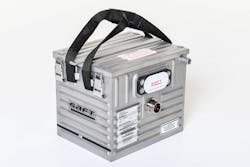Saft: Powering Aviation Yesterday, Today and Tomorrow

Saft batteries have been in aircraft since 1932. Primarily, their role has been to start engines and provide emergency backup power.
A subsidiary of TotalEnergies, Saft specializes in advanced technology battery solutions.
The first-generation nickel-cadmium (Ni-Cd) batteries were replaced in 1938 by Saft’s Voltabloc batteries that used a sintered-plate process and had five times more power. Thin sintered-plate batteries followed 20 years later.
Saft ULM (ultra-low maintenance) Ni-Cd batteries with lightweight plastic-bonded electrode (PBE) technology debuted in 1996. An improvement over sinter technology, the combination of plastic-bonded electrodes and superior separator systems reduces overcharge current at both high and low temperatures. This reduces water consumption, slows battery aging and provides added safety, especially at high temperatures.
“The primary advantage of the ULM technology over the existing batteries at that time had to do with increasing maintenance intervals,” said Chuck Schofield, vice president, Saft Aviation Sales & Marketing Aerospace, Defense, and Performance (ADP) Division. “In other words, expanding the time that the carriers or the operators of the batteries were required to do maintenance. In many cases, the ULM technology doubled or in some applications was up to four times the existing technology.”
With batteries, new features or functions aren’t always obvious. “The design features are found within the electrochemistry,” he said. “These subtle design benefits aren't always obvious to the eye. Because Saft designs to the molecular level, we have a unique ability to tailor to the OEM performance criteria.”
Without question, Schofield said the primary benefit of the ULM battery has been expanding reliability by applying a proven design to multiple applications.
The first aircraft to use a Saft ULM battery was the Gulfstream V. Today, more than 60 ULM batteries are in serial production for jetliners, military jets, regional jets, turboprops, business jets, helicopters and even drones.
By expanding the maintenance intervals, the Saft ULM product became more attractive to operators looking to reduce costs across all segments including business aviation, commercial and military, Schofield said.
For new installations or retrofits, no aircraft modification is required.
With proper maintenance, a Saft ULM battery can last up to 10 years.
“As long as the Saft CMM (component maintenance manual) requirements are followed, a Part 145 repair facility with the proper capabilities should be able to maintain Saft batteries,” he said. “This proper battery care will allow operators to achieve the best product lifecycle possible.”
Many of the batteries in aircraft today could be considered mature technology.
“There is a transition going on in the market both in the traditional aviation market, and as we enter in the emerging market of advanced air mobility,” Schofield said. Both are furthering not only Ni-Cd in many applications, but also lithium technologies.
“In the world of batteries, especially as it applies to aviation, safety is the primary focus,” he said. “As we move into the lithium market, Saft takes an extremely conservative approach as it relates to safety. There are technologies available today that we could take to market, but we’re not comfortable with the safety or performance levels that those offer. Our ultimate objective is to provide the industry with a safe technology that we feel confident enough in to fly our own families aboard."
Saft, along with its parent company TotalEnergies, is hyper focused on sustainability, as well, he added.
Spent nickel-based batteries can be returned to Saft’s worldwide network with more than 30 bring-back points. According to Saft, it has the only plant in the world that produces Ni-Cd batteries incorporating metals that have been reclaimed on site from spent batteries. “Out of 1 ton of used nickel-based batteries returned for recycling, over 750 kg of valuable materials are extracted and reused by industry. Metallurgical processes with enhanced efficiency extract over 95% of the weight of key metals such as cobalt, nickel, and copper from a wide variety of battery chemistries.”
Another focus for battery development continues to be lighter weight.
With 400 battery models, Saft outfits 80 percent of the world’s commercial and military aircraft, including all Airbus aircraft and 70 percent of Boeing aircraft. Every 2 seconds, a Saft aviation battery takes off.
About the Author
Rebecca Kanable
Assistant Editor
Rebecca Kanable, a veteran journalist, worked with Endeavor Business Media's aviation group from 2021 to 2024 as assistant editor of Airport Business, AMT and Ground Support Worldwide. She previously worked for various publications, including trade magazines and newspapers.
